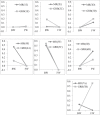In absence of local adaptation, plasticity and spatially varying selection rule: a view from genomic reaction norms in a panmictic species (Anguilla rostrata)
- PMID: 24884429
- PMCID: PMC4229938
- DOI: 10.1186/1471-2164-15-403
In absence of local adaptation, plasticity and spatially varying selection rule: a view from genomic reaction norms in a panmictic species (Anguilla rostrata)
Abstract
Background: American eel (Anguilla rostrata) is one of the few species for which panmixia has been demonstrated at the scale of the entire species. As such, the development of long term local adaptation is impossible. However, both plasticity and spatially varying selection have been invoked in explaining how American eel may cope with an unusual broad scope of environmental conditions. Here, we address this question through transcriptomic analyses and genomic reaction norms of eels from two geographic origins reared in controlled environments.
Results: The null hypothesis of no difference in gene expression between eels from the two origins was rejected. Many unique transcripts and two out of seven gene clusters showed significant difference in expression, both at time of capture and after three months of common rearing. Differences in expression were observed at numerous genes representing many functional groups when comparing eels from a same origin reared under different salinity conditions. Plastic response to different rearing conditions varied among gene clusters with three clusters showing significant origin-environment interactions translating into differential genomic norms of reaction. Most genes and functional categories showing differences between origins were previously shown to be differentially expressed in a study comparing transcription profiles between adult European eels acclimated to different salinities.
Conclusions: These results emphasize that while plasticity in expression may be important, there is also a role for local genetic (and/or epigenetic) differences in explaining differences in gene expression between eels from different geographic origins. Such differences match those reported in genetically distinct populations in other fishes, both in terms of the proportion of genes that are differentially expressed and the diversity of biological functions involved. We thus propose that genetic differences between glass eels of different origins caused by spatially varying selection due to local environmental conditions translates into transcriptomic differences (including different genomic norms of reaction) which may in turn explain part of the phenotypic variance observed between different habitats colonized by eels.
Figures


References
-
- Côté CL, Gagnaire P-A, Bourret V, Verreault G, Castonguay M, Bernatchez L. Population genetics of the American eel (Anguilla rostrata): F(ST) = 0 and North Atlantic Oscillation effects on demographic fluctuations of a panmictic species. Mol Ecol. 2013;22(7):1763–1776. - PubMed
-
- Pratt TC, Threader RW. Preliminary evaluation of a large-scale American eel conservation stocking experiment. North Am J Fisheries Manage. 2011;31(4):619–627.
-
- Tremblay V. In: Eels at the edge: science, status, and conservation concerns. vol. Symposium 58. Casselman JM, Cairns DK, editor. Bethesda: American Fisheries Society; 2009. Reproductive strategy of female American eels among five subpopulations in the St. Lawrence River Watershed; pp. 85–102.
-
- Jessop BM, Shiao JC, Iizuka Y, Tzeng WN. Migratory behaviour and habitat use by American eels Anguilla rostrata as revealed by otolith microchemistry. Mar Ecol Prog Ser. 2002;233(2):217–229.
-
- Jessop BM. Geographic effects on American eel (Anguilla rostrata) life history characteristics and strategies. Can J Fish Aquat Sci. 2010;67(2):326–346.
Publication types
MeSH terms
LinkOut - more resources
Full Text Sources
Other Literature Sources
Research Materials

